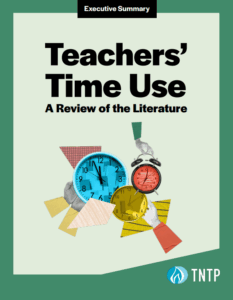Career-connected learning aims to link academic learning with real-world experiences—starting as early as elementary school and continuing throughout a student’s PK–12 journey. At TNTP, we believe in the power of CCL to not only make learning more relevant but to prepare young people for thriving lives beyond the classroom.
Through CCL, students explore career options, develop durable skills such as critical thinking, adaptability, and communication, and apply what they’re learning in the classroom to real-life contexts. At its best, an integrated CCL approach can significantly contribute to the economic and social mobility of young people, but only if we ensure programs are truly preparing students for high-wage, high-skill, in-demand professions.
In a typical high school today, students often explore specific career-technical education pathways such as programs that track them into careers in health science, marketing and business, and information technology, or trades such as welding and carpentry. These pathways may provide students with avenues for earning credentials for specific jobs available after graduation. However, many career-connected learning programs and pathways aren’t actually preparing students for quality, in-demand jobs – even when they intend to.
A 2020 study of data from 30 states didn’t find a single state where the credentials earned by high school students closely aligned to demand for those credentials in the job market. In fact, the study found that for secondary students, just 18% of the credentials earned were in demand by U.S. employers.
These results are not because there is a lack of interest or care in preparing students for the future workforce. Schools face a number of challenges when developing strong career-connected learning pathways, including: a lack of data about how well their current programs are working, difficulty establishing partnerships with employers, and the complicated logistics of blending school schedules and culture with CCL engagement. If we want schools to build transformative career-connected learning pipelines that help expand students’ opportunities, more support and investment is needed at the state and district level.
How States Can and Should Help: Conduct an Annual Return on Investment Analysis
States are well-positioned to dramatically strengthen career-connected learning pathways. One way to do that is to offer in-depth, return on investment analysis that provides clear, comprehensive information about how well programs serve students and prepare them with the skills they need to succeed in today’s workforce.
We know this is on the minds of state leaders as the bipartisan National Governors Association’s recent initiative, “Let’s Get Ready!” explicitly calls on states to build systems and infrastructure to measure outcomes. Specifically, a strong return on investment study evaluates just that: to what extent are the specific pathways students are enrolled in leading to good jobs.
Colorado and Florida currently publish return-on-investment reports for some or all of the degree and credential pathways offered in their state, and three more states (Georgia, Indiana, and Louisiana) passed bills in their most recent legislative session calling for a similar analysis.
Return on investment studies are crucial to ensure that pathways live up to their promise and lead to the high-wage, high-demand, and high-skill jobs that support thriving futures for young people.
Specifically, ROI studies have the power to:
Signal quality.
Whether it’s through guidelines, resources and trainings, or providing in-depth data for school systems to use, states have the power to set high standards that districts can look to as they determine the best career pathways to offer in their schools. State policymakers can help establish a bar for what good career-connected learning is by focusing their analysis and reporting on the outcomes that matter most for the students in their state. This vision for where students should be heading supports districts and schools to ask the right questions about their own pathways and programs. For example:
- Does your school system support career-connected learning that leads to good jobs across PK-12 or just at the secondary level?
- What roles and resources are in place to support those opportunities?
- Is career-learning integrated into the core curriculum so that students can actively link their academic learning to high-wage, high-skill, and high-demand career options?
Provide clear data on how well current pathways are preparing young people for quality jobs.
A strong return-on-investment report provides information on all components of “good jobs” and should help districts answer the following kinds of questions:
- What do completers of a given pathway earn in the workforce and how do their wages grow over time?
- To what extent are earners of a given credential completing high school; to what extent are they enrolling in and completing community college and/or four-year colleges?
- Which careers are in demand across the state?
- Are completers hired and retained in high-demand jobs related to the credential they earned?
Offering this kind of in-depth data can help ensure that districts are making evidence-based decisions and that students’ needs and workforce readiness remain central as adjustments are considered.
Support districts to offer career-connected learning experiences that align to industry demand and desired student outcomes.
The results of the ROI study will enable state leaders to identify the courses, credentials, and career-connected learning experiences that best serve students and employers. Coupled with an understanding of the state’s labor markets, state leaders can answer questions such as:
- Which career clusters and corresponding courses should be prioritized in CCL programs?
- Which credentials are industry-recognized and can build on one-another, as well as contribute to postsecondary degrees
- What are the high-wage, in-demand jobs in each region?
With this understanding, the state will be well positioned to leverage weighted funding formulas to incentivize districts to align their programs to the best practices surfaced in the ROI study, statewide workforce priorities, and regional needs.
Data-Driven Decisions for Lasting Impact
Strong career-connected learning has tremendous potential to increase economic and social mobility for millions of young people. But only if school systems make decisions grounded in data, have adequate resources, and ensure that the learning is truly connected to the great jobs of today and the future. Annual return on investment studies are an important policy lever states can pull to support districts to turn the promise of career learning into a reality.







